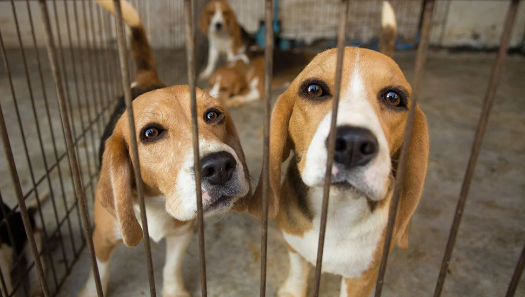Put Your Paw Down; Save the Animals

Some beagles locked in a cage in between experimentation.
December 12, 2022
Animal testing is a term that refers to the procedures performed on living animals to research further into biology and diseases. The term refers to testing the effectiveness of new medical products, human health, or environmental safety of consumer and industry products. Such products include household cleaners, cosmetics, food additives, pharmaceuticals, and industrial/agrochemicals. While many species are held captive for animal testing, the most common are mice, fish, rats, rabbits, guinea pigs, hamsters, farm animals, cats, dogs, mini-pigs, and non-human primates.
All the procedures on these animals can potentially cause physical and psychological distress to the animal, no matter how mild they are. Many of the animals pass away due to the experimentation they undergo. Some survive and end up being the subject of more tests. Some of the procedures that these animals undergo include:
- Forced chemical exposure
- Exposure to infectious diseases at levels that cause illness, pain, distress, or death
- Genetic manipulation
- Ear-notching and tail clipping
- Short or prolonged periods of physical restraint
- Food and water deprivation
- Surgical procedures followed by recovery
- Infliction of burns and wounds to study
- Infliction of pain to study
- Other manipulations to create animal models of human diseases ranging from cancer to stroke to depression
Due to how cruel the experiments have been toward animals, scientists are developing and using animal-free methods for studying diseases and testing products; these methods are relevant to human health. Some of the alternatives for animal testing include:
- In Vitro testing
- Computer (In Silico) testing
- Human Volunteers
- Human-patient Simulators
In Vitro testing
Researchers created organs-on-chips that contain human cells grown to mimic the structure and function of human organs and organ systems. In Vitro can be used in disease research and toxicity testing and provide more accurate information than animal testing.
Computer (In Silico) testing
A wide range of sophisticated computer models has developed. These models simulate human biology and the progression of developing diseases. Research reveals that these models can accurately predict ways new substances will react in the human body.
Human Volunteer testing
Microdosing can provide vital information on the safety of an experimental substance and how it metabolizes in humans before large-scale human trials. Volunteers receive a small, one-time dose. They use sophisticated imaging techniques to monitor how it behaves within the body. Microdosing can replace animal testing in some categories and help determine compounds that will not work in humans.
Human-Patient Simulators
Life-like, computerized human-patient simulators that breathe, bleed, talk, convulse, and “die”, have been shown to teach students physiology and pharmacology crude animal exercises. High-tech simulators imitate illnesses and injuries while giving the appropriate biological response to medical interventions.
Despite having safe, non-animal testing, methods for conducting experiments, scientists continue to use animals to test their products and substances. The animals are being used for experimentation “without consent.” Scientists should switch their methods and conduct their experiments on someone who has a voice and can consent or on something that imitates a human.
